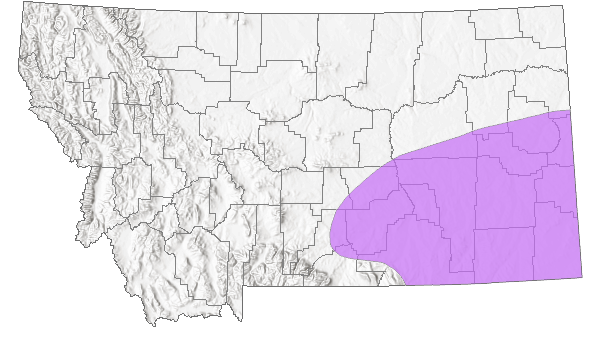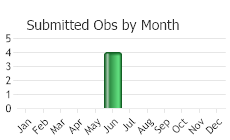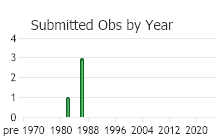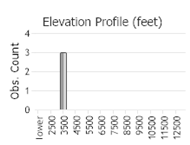View in other NatureServe Network Field Guides
NatureServe
Montana
Utah
Wyoming
Idaho
Wisconsin
British Columbia
South Carolina
Yukon
California
New York
Blue Toadflax - Nuttallanthus texanus
Other Names:
Linaria canadensis var. texana, Linaria texana
State Rank Reason (see State Rank above)
Known from one extant occurrence in southeastern Montana near Alzada and another occurrence from Makoshika State Park. Additional surveys and monitoring are needed.
- Details on Status Ranking and Review
Population Size
Score2-3 - Very Small to Small: Population size is imprecisely known but is believed to be <10,000 individuals.
Range Extent
Score2 - Regional or State Endemic or Small Montana Range: Generally restricted to an area <100,000 sq. miles (equivalent to 2/3 the size of Montana or less) or Montana contributes 50% or more of the species’ range or populations OR limited to 2-3 Sub-basins in Montana.
Area of Occupancy
Score3 - Very Low: Generally occurring in 3 or fewer Subwatersheds (6th Code HUC’s).
Environmental Specificity
Score1 - Moderate: Species is restricted to a specific habitat that is more widely distributed or to several restricted habitats and is typically dependent upon relatively unaltered, good-quality habitat (C Values of 5-7).
Trends
Score2 - Moderate Declines: Species has experienced declines of 30-50% in population size, range extent and/or occupied area in the recent past (approximately 30 years).
CommentPopulation trends are unknown, though habitat quality appears to have declined due to non-native species. Population levels probably fluctuate greatly from year to year.
Threats
Score1-2 - Medium to High.
CommentInvasive species have the potential to detrimentally impact this species and its habitat.
Intrinsic Vulnerability
Score1-2 - Moderate to High Vulnerability.
Raw Conservation Status Score
Score
12 to 15 total points scored out of a possible 19.
General Description
Blue Toadflax is a slender annual with erect, unbranched stems that are 1-5 dm tall. There is a rosette of prostrate stems at the base, the leaves of which are narrowly oblong, 5-10 mm long, and opposite or in whorls of 3. Stem leaves are narrower, and the lower are opposite or in whorls of 3, becoming alternate above. Foliage is glabrous, often with a thin, bluish, waxy coating. Short-stalked flowers are borne in an elongating, spike-like inflorescence. The snapdragon-like blue flowers are 8-12 mm long and have 5 sepals and a 2-lipped corolla. The lower lip is horizontal and 3-lobed, while the upper is 2-lobed and erect. There is a linear, downcurved spur that is 2-11 mm long and located at the base of the corolla. The fruit is a globose, many-seeded capsule that is 2-4 mm high.
Phenology
Flowering in May-June.
Diagnostic Characteristics
The blue, spurred flowers and basal rosette of prostrate stems are diagnostic.
Species Range
Montana Range
Range Descriptions

 Native
Native
Range Comments
Midwest, Southeast and Pacific Coast from B.C. to Mexico. Peripheral.
Observations in Montana Natural Heritage Program Database
Number of Observations: 5
(Click on the following maps and charts to see full sized version)
Map Help and Descriptions
Relative Density

Recency



 (Observations spanning multiple months or years are excluded from time charts)
(Observations spanning multiple months or years are excluded from time charts)
Habitat
Open, sandy or acid shale soils of grasslands and woodlands on the plains. Habitat for occurrence near Alzada is described as pine-oak-juniper woodland on Mowry shale-clay with Cryptantha torreyana, Mentzelia dispersa, Mentzelia albicaulis and Vulpia octoflora.
National Vegetation Classification System Groups Associated with this Species
Forest and Woodland
Low Elevation - Xeric Forest and Woodland
Grassland
Lowland - Prairie Grassland
Ecology
Blue toadflax is a winter annual (germinates in the fall) thus germination and seedling development are most affected by soil moisture availability in the fall.
Stewardship Responsibility
Threats or Limiting Factors
STATE THREAT SCORE REASON
Reported threats to Montana’s populations of Blue Toadflax are due to active bentonite mining in the vicinity of most (MTNHP Threat Assessment 2021). Moderate to serious negative impacts are expected to lead to population decline.
References
- Literature Cited AboveLegend:
 View Online Publication
View Online Publication MTNHP Threat Assessment. 2021. State Threat Score Assignment and Assessment of Reported Threats from 2006 to 2021 for State-listed Vascular Plants. Botany Program, Montana Natural Heritage Program, Helena, Montana.
MTNHP Threat Assessment. 2021. State Threat Score Assignment and Assessment of Reported Threats from 2006 to 2021 for State-listed Vascular Plants. Botany Program, Montana Natural Heritage Program, Helena, Montana.
- Additional ReferencesLegend:
 View Online Publication
View Online Publication
Do you know of a citation we're missing? Lesica, P., M.T. Lavin, and P.F. Stickney. 2012. Manual of Montana Vascular Plants. Fort Worth, TX: BRIT Press. viii + 771 p.
Lesica, P., M.T. Lavin, and P.F. Stickney. 2012. Manual of Montana Vascular Plants. Fort Worth, TX: BRIT Press. viii + 771 p. Lesica, P., M.T. Lavin, and P.F. Stickney. 2022. Manual of Montana Vascular Plants, Second Edition. Fort Worth, TX: BRIT Press. viii + 779 p.
Lesica, P., M.T. Lavin, and P.F. Stickney. 2022. Manual of Montana Vascular Plants, Second Edition. Fort Worth, TX: BRIT Press. viii + 779 p. Vanderhorst, J.P., S.V. Cooper, and B.L. Heidel. 1998. Botanical and vegetation survey of Carter County, Montana. Unpublished report prepared for the Bureau of Land Management. Montana Natural Heritage Program, Helena. 116 pp. + app.
Vanderhorst, J.P., S.V. Cooper, and B.L. Heidel. 1998. Botanical and vegetation survey of Carter County, Montana. Unpublished report prepared for the Bureau of Land Management. Montana Natural Heritage Program, Helena. 116 pp. + app.
- Web Search Engines for Articles on "Blue Toadflax"





